Themed collection Metal Interactions with Nucleic Acids

Metal interactions with nucleic acids
Welcome to the Dalton Transactions ‘metal interactions with nucleic acids’ themed issue.

Dalton Trans., 2015,44, 3503-3504
https://doi.org/10.1039/C5DT90025E
Metal complex interactions with DNA
Increasing numbers of DNA structures are being revealed using a diverse range of transition metal complexes and biophysical spectroscopic techniques. Here we present a review of metal complex-DNA interactions in which several binding modes and DNA structural forms are explored.
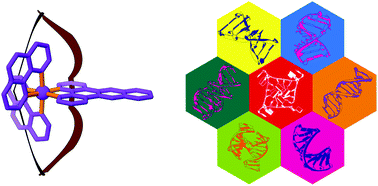
Dalton Trans., 2015,44, 3505-3526
https://doi.org/10.1039/C4DT02700K
Zinc complexes as fluorescent chemosensors for nucleic acids: new perspectives for a “boring” element
Recent applications of zinc(II) complexes as fluorescent probes for nucleic acids are described highlighting their potential as diagnostic tools.
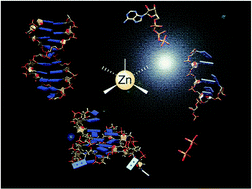
Dalton Trans., 2015,44, 3527-3535
https://doi.org/10.1039/C4DT02881C
Unprecedented dinuclear silver(I)-mediated base pair involving the DNA lesion 1,N6-ethenoadenine
For the first time, a dinuclear purine-based metal-mediated homo base pair has been incorporated into a B-DNA duplex.
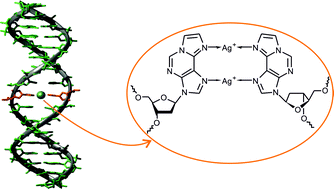
Dalton Trans., 2015,44, 3540-3543
https://doi.org/10.1039/C4DT02663B
Convenient detection of metal–DNA, metal–RNA, and metal–protein adducts with a click-modified Pt(II) complex
cis-[Pt(2-azido-1,3-propanediamine)Cl2] is a reagent for high-yield post-treatment fluorescent labelling of Pt(II) biomolecular targets using click chemistry and exhibits a bias in conformational isomers in the context of duplex DNA.
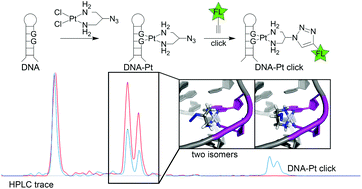
Dalton Trans., 2015,44, 3536-3539
https://doi.org/10.1039/C4DT02649G
Antitumor properties of platinum(IV) prodrug-loaded silk fibroin nanoparticles
We have successfully generated silk nanoparticles loaded with the hydrophobic platinum(IV) antitumor prodrug PtBz achieving high cell selectivity factors.
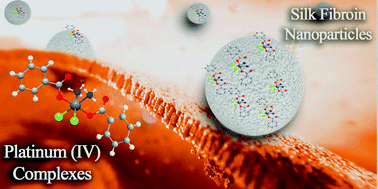
Dalton Trans., 2015,44, 13513-13521
https://doi.org/10.1039/C5DT00378D
Binding of an organo–osmium(II) anticancer complex to guanine and cytosine on DNA revealed by electron-based dissociations in high resolution Top–Down FT-ICR mass spectrometry
Binding of an organo–osmium anticancer complex not only to guanine but also cytosine on DNA is revealed by electron-detachment dissociation tandem MS.
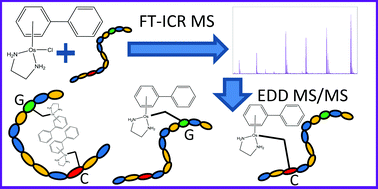
Dalton Trans., 2015,44, 3624-3632
https://doi.org/10.1039/C4DT03819C
Cobalt(III)porphyrin to target G-quadruplex DNA
A bulky cationic cobalt(III) porphyrin carrying two water molecules as axial ligands interacts in a π-stacking like mode with the 5′-external guanine quartet of G-quadruplex DNA.
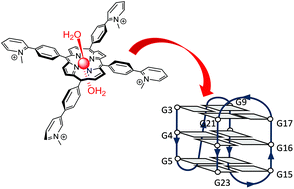
Dalton Trans., 2015,44, 3701-3707
https://doi.org/10.1039/C4DT03631J
Photoinduced interactions of two dirhodium complexes with d(GTCGAC)2 probed by 2D NOESY
2D 1H–1H NOESY reveals that irradiation of cis-H,H-[Rh2(HNOCCH3)2(dppz)(CH3CN)4]2+ results in covalent binding and end-capping of the complex to d(GTCGAC)2.
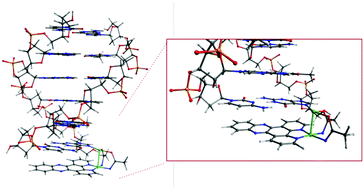
Dalton Trans., 2015,44, 3640-3646
https://doi.org/10.1039/C4DT03119A
Redox-active and DNA-binding coordination complexes of clotrimazole
The coordination compounds bind to DNA by two different binding modes depending on the concentration, sequence of the DNA, and the structure of the complex.
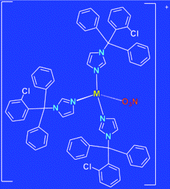
Dalton Trans., 2015,44, 3673-3685
https://doi.org/10.1039/C4DT02883J
Bifunctional Zn(II) complexes for recognition of non-canonical thymines in DNA bulges and G-quadruplexes
The aromatic pendent groups of Zn(II) tetraazamacrocyclic complexes were varied to study their role in the recognition of non-canonical thymines in a DNA bulge and in the human telomeric G-quadruplex.
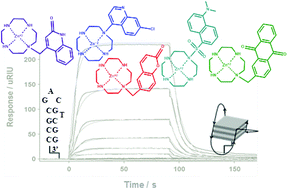
Dalton Trans., 2015,44, 3708-3716
https://doi.org/10.1039/C4DT03004D
Mono- and dinuclear metal complexes containing the 1,5,9-triazacyclododecane ([12]aneN3) unit and their interaction with DNA
It takes two to tango: Only the dinuclear but not the mononuclear metal complexes of triazacyclododecane ([12]aneN3) were able to induce the Z-DNA of poly d(GC).
![Graphical abstract: Mono- and dinuclear metal complexes containing the 1,5,9-triazacyclododecane ([12]aneN3) unit and their interaction with DNA](/en/Image/Get?imageInfo.ImageType=GA&imageInfo.ImageIdentifier.ManuscriptID=C4DT02713B&imageInfo.ImageIdentifier.Year=2015)
Dalton Trans., 2015,44, 3664-3672
https://doi.org/10.1039/C4DT02713B
Solution studies on DNA interactions of substitution-inert platinum complexes mediated via the phosphate clamp
NMR studies confirmed phosphate clamp–DNA binding in solution and the sequence dictates minor-groove spanning or backbone tracking.

Dalton Trans., 2015,44, 3563-3572
https://doi.org/10.1039/C4DT03237C
Binding of copper(II) polypyridyl complexes to DNA and consequences for DNA-based asymmetric catalysis
Insight into the structure of DNA-based catalysts is obtained by elucidation of the DNA-binding mode of catalytically active copper complexes.
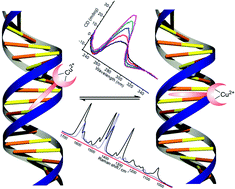
Dalton Trans., 2015,44, 3647-3655
https://doi.org/10.1039/C4DT02733G
Characterisation of the interactions between substrate, copper(II) complex and DNA and their role in rate acceleration in DNA-based asymmetric catalysis
High effective molarity is responsible for the significant increase of binding of substrates to copper(II) complexes in DNA-based catalysis.
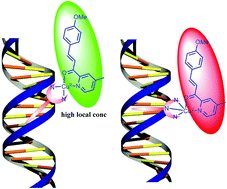
Dalton Trans., 2015,44, 3656-3663
https://doi.org/10.1039/C4DT02734E
Interactions of selected gold(III) complexes with DNA G quadruplexes
The interactions of three Au(III) complexes with human telomeric DNA sequences: Auoxo6 turned out to be very effective in inducing and binding the G-quadruplex DNA conformation.
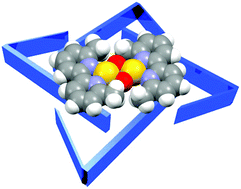
Dalton Trans., 2015,44, 3633-3639
https://doi.org/10.1039/C4DT02698E
The induction of lysis in lysogenic strains of Escherichia coli by a new antitumor transplatin derivative and its DNA interactions
DNA is the cellular target for antitumor derivatives of transplatin including those containing small aliphatic amino ligands.
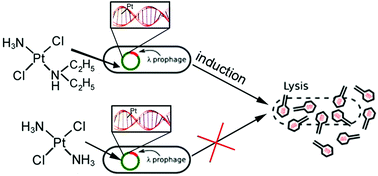
Dalton Trans., 2015,44, 3573-3582
https://doi.org/10.1039/C4DT02603A
Competitive formation of DNA linkage isomers by a trinuclear platinum complex and the influence of pre-association
The trinuclear platinum drug BB3464 pre-associates in the minor groove at two different sites on a 14-mer duplex and this dictates the nature of the adducts formed in both 5′-5′ and 3′-3′ directions.

Dalton Trans., 2015,44, 3583-3593
https://doi.org/10.1039/C4DT02942A
Protein ruthenation and DNA alkylation: chlorambucil-functionalized RAPTA complexes and their anticancer activity
The conjugation of chlorambucil to the RAPTA scaffold results in an anticancer active agent capable of cross-linking DNA and proteins.
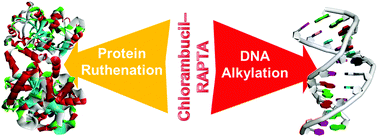
Dalton Trans., 2015,44, 3614-3623
https://doi.org/10.1039/C4DT02764G
Binding of Ru(terpyridine)(pyridine)dipyridophenazine to DNA studied with polarized spectroscopy and calorimetry
Achiral Ru(tpy)(py)dppz2+ intercalated into DNA has similar intermolecular interactions as opposite enantiomers of its structural isomer, the “light-switch” complex Ru(bpy)2dppz2+.
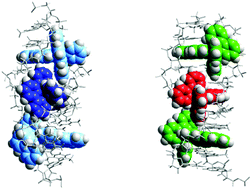
Dalton Trans., 2015,44, 3604-3613
https://doi.org/10.1039/C4DT02642J
RNA and DNA binding of inert oligonuclear ruthenium(II) complexes in live eukaryotic cells
Oligonuclear polypyridylruthenium(II) complexes show selectivity for the nucleus of eukaryotic cells with a considerable preference for the RNA-rich nucleolus.

Dalton Trans., 2015,44, 3594-3603
https://doi.org/10.1039/C4DT02575J
Syntheses of polypyridyl metal complexes and studies of their interaction with quadruplex DNA
A series of metal complexes with substituted terpyridines show high affinity towards quadruplex DNA, particularly bimetallic (trpy)Pt/M(cyclen) complexes.
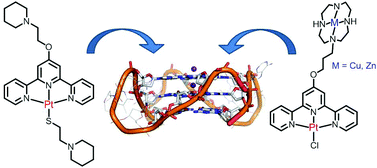
Dalton Trans., 2015,44, 3686-3700
https://doi.org/10.1039/C4DT02910K
Synthesis, cytotoxicity, DNA interaction and cell cycle studies of trans-diiodophosphine Pt(II) complexes
Diiodido phosphine Pt complexes were synthesized and their biological activity studied. The complex with isopropylamine was the best candidate.

Dalton Trans., 2015,44, 3557-3562
https://doi.org/10.1039/C4DT02392G
DNA fragment conformations in adducts with Kiteplatin
The anticancer-active platinum complex with cis-1,4-diaminocyclohexane has proved to be very valuable in detecting multiple conformers in adducts with oligonucleotides.
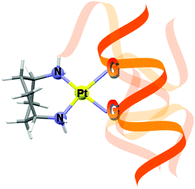
Dalton Trans., 2015,44, 3544-3556
https://doi.org/10.1039/C4DT01796J
About this collection
Guest edited by Professor Dr Jan Reedijk (Leiden University) and Professor Michael Hannon (University of Birmingham), this issue highlights a diverse number of topics within metal-nucleic acid chemistry.